As far back as I can remember, I heard stories about my father’s family in Independence, MO. We were told that the painting we had above our couch for years was of a relative whose friend had accidentally shot him to death during the night as they slept in a room above a bank in the 1800’s. My sister and I were given an article about our ancestors when we were teenagers (written in the 1960’s), telling, among other things, about an uncle who was the first mayor of Independence, and about being locked in the bank’s vault during a bank robbery. The robbers were even suspected to be Jesse James and his gang.
It wasn’t until I was in my early 50’s, and had my first grandchild, that my interest in Independence really took hold, and turned into an all out obsession. I published my first short story, and I decided I wanted to put together a collection of stories written by family members or about family members so they could be enjoyed by generations to come. I found stories I had written in school, stories my daughter had written in school, letters from my father while in the Navy, and the article about our family in Independence. In the article, it mentioned that my great great grandfather, John McCoy, had some stories published in the newspaper in Kansas City about his travels around the west in the 1800’s. These stories seemed quite interesting to me, so I contacted the Jackson County, MO, Historical Society via email to see if they knew where I could get copies of these stories, since the historical society had published the article about my family members. They answered me and suggested I see if I could get them by making an inter-library request, which I did, and never received the stories. In the email from the historical society, they mentioned a lady named Sharon Snyder who was currently living in the original William McCoy house, and they said I had her permission to contact her via email. William McCoy was John McCoy’s brother, who was the first mayor of Independence, among other things. Some time passed, I contacted Sharon, and thus began a wonderful friendship and a source of more information and stories about my family then I could’ve ever imagined. She sent me a book on the McCoy neighborhood, old photos, articles about the accomplishments of the McCoys, including stories written by John, and information tracing my ancestors to the 1700’s when they came to the U.S. from Scotland. I eagerly put everything together into a scrapbook, thinking that would be the extent of my project, until I received another book from Sharon that changed everything.
Shortly before Christmas 2009, Sharon sent me a book titled, “Deaths on Pleasant Street,” by Giles Fowler. She said it was about a famous murder that took place in Independence in 1909, and that William and John McCoy’s granddaughters were friends of the victim’s family, and were mentioned in the book, so she thought I might enjoy it. I love a good murder mystery, especially a true story, so I began reading it shortly after I received it. To my surprise, I found that I was also directly related to the murder victims. The story is about the murders of several members of the prominent Independence and Kansas City, MO, family, the Swopes, including the very wealthy Thomas Swope, who gave huge Swope Park to the people of Kansas City. Thomas Swope’s brother, Logan, was married to Maggie Chrisman, who was the aunt of my great grandmother, Lucy Chrisman McCoy. Logan Swope was deceased, and Thomas Swope was living in the mansion in Independence with Maggie and her children, (my cousins, Lucy’s first cousins.) Thomas Swope, his cousin Moss Hunton, and Maggie’s son Chrisman Swope were all suspected to be murdered by Maggie’s daughter’s husband, Dr. Hyde. I could not believe I had never heard this story before. It was huge at the time, being in the New York Times and Chicago newspapers. My father was deceased, so I called my mother to ask her about it. She hadn’t heard the story either, but had an old envelope with McCoy things in it that she said I could look through.
The envelope contained letters written by John McCoy and his son, Stewart, who was shot in the room above the bank, and some old tin photos. I transcribed the letters, and sent the originals and some photos to the Jackson County Historical Society, and continued writing Sharon. She mentioned how fun it would be to show me her house and other historical places in Independence. I was interested in seeing everything, but thought the trip would be pretty much impossible because of how far Independence was from Batavia, Ohio, among other things.
Things changed, however, in the early part of 2010 when I was laid off from my job, making it easier for me to plan a spontaneous trip, also, my step father drove through Independence on his way to Kansas, and said the drive was only about 10 hours, and I found out the Jackson County Historical Society was having a re-enactment of the Swope murder trial in Independence on June 12, 2010, to celebrate the 100 year anniversary of the trial. There were no excuses not to go now. My husband requested the time off from work, I purchased tickets to the performance, and reserved room at a local bed and breakfast, and we were on our way.
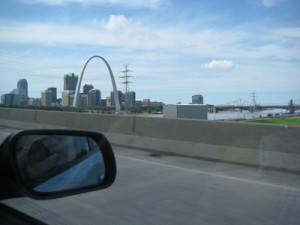 We hit the road early, barreling into Kentucky, then Indiana, Illinois, and finally Missouri. It seemed like the drive lasted forever because the land was flat with nothing but farmland as far as the eye could see. I thought often about the millions of travelers who took this route in the past, from early settlers in covered wagons and on horseback to the poor folks depicted in “The Grapes of Wrath.” I felt the lawlessness of the area too that bred men like Jesse James. As we approached St. Louis, MO, we actually missed the turn off to by-pass the city, so we drove straight through and got a nice look at the famous arch.
We hit the road early, barreling into Kentucky, then Indiana, Illinois, and finally Missouri. It seemed like the drive lasted forever because the land was flat with nothing but farmland as far as the eye could see. I thought often about the millions of travelers who took this route in the past, from early settlers in covered wagons and on horseback to the poor folks depicted in “The Grapes of Wrath.” I felt the lawlessness of the area too that bred men like Jesse James. As we approached St. Louis, MO, we actually missed the turn off to by-pass the city, so we drove straight through and got a nice look at the famous arch.
 When we approached Independence, we noticed another modern landmark that was visible for miles. It was the unusually shaped steeple at the Mormon temple in Independence. Apparently, Mormon founder John Smith had a revelation that Independence, MO, was sacred ground and had a temple built there. There is now a large Mormon following in Independence, and this modern steeple towers above the town and is visible from miles away.
When we approached Independence, we noticed another modern landmark that was visible for miles. It was the unusually shaped steeple at the Mormon temple in Independence. Apparently, Mormon founder John Smith had a revelation that Independence, MO, was sacred ground and had a temple built there. There is now a large Mormon following in Independence, and this modern steeple towers above the town and is visible from miles away.
Our hotel was also a Mormon run bed and breakfast. It was called “The Higher Ground Bed and Breakfast,” and was relatively modern for the area. The furnishings were antiques, which I liked because they made me feel like I was going back in time. Breakfast was very limited, the room was hot at night because they turned off the air conditioning for some reason, and, strangely, the birds were very loud, waking us up at 3:00 a.m. with their loud chirping. After we checked 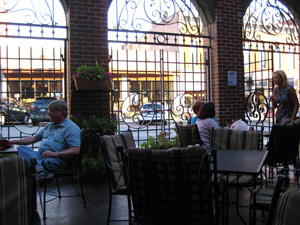 into the hotel, we found a nice place to eat near the square, which is the center of Independence. We ate at Verona’s, outside beside a fountain. It was wonderful after our long drive.
into the hotel, we found a nice place to eat near the square, which is the center of Independence. We ate at Verona’s, outside beside a fountain. It was wonderful after our long drive.
After a restless night, we were thrilled to be picked up in the morning by Sharon Snyder and her friend Jenell Yoka for a personal tour. We started the day with an informative and entertaining covered-wagon ride around the center of town, pulled by real Missouri Mules. The driver told us about the rich history of Independence, where fighting between members of north and south 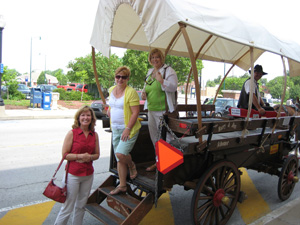 started long before the Civil War. It was also a very busy town, having some of the main covered-wagon trails going through it and it was an important delivery junction on the Missouri River.
started long before the Civil War. It was also a very busy town, having some of the main covered-wagon trails going through it and it was an important delivery junction on the Missouri River.
In fact, the words of John McCoy, himself, describe it best. John McCoy wrote some articles late in his life about his travels in the west that were published in The Jackson Examiner newspaper. The source of the following is The Centennial History of Independence, by W.L. Webb, 1927:
John McCoy, addressing the old settlers’ meeting, said:
“Independence was selected as a place of arrival and departure as well as an outfitting place for trappers and hunters of the mountains and Western plains. It was well worthwhile to witness the arrival of some of the pack-trains. Before entering they gave notice of their arrival by the shooting of guns, so that when they reached the Owens and Aull store a goodly number of people were there to welcome them. A greasy, dirty set of men they were. Water, surely was a rare commodity with them. They little cared for it except to slack their thirst. Their animals were loaded down with heavy packs of buffalo robes and peltry. Occasionally they had a small wagon, which, after long usage, had the fellies and spokes wrapped with rawhide to keep the vehicle from falling to pieces. So accustomed were they to their work that it took them little time to unload the burdens from the backs of the animals and store their goods in the warehouse. The trappers let the merchants attend to the shipping. The arrival at Independence was always a joyous ending of a hazardous trip, and when once safely over it, they were always ready for a jolly time, which they had to their hearts’ content. They made the welkin ring and filled the town with high carnival for many days.
“The mountain trade at length gave way to the Mexican trade, this being on a much larger scale. Pack mules and donkeys were discarded and wagons drawn by mules and oxen were substituted. Such men as David Waldo, Solomon Houke, William and Solomon Sublett, Josiah Gregg, St. Vrain, Charvez and others of like character were early adventurers, and as the government gave permission to enter and trade with the people, they ventured across the plains regardless of danger. Samuel C. Owens, it is said, was the first trader in Independence. He came to Missouri from Kentucky when he was a young man. He was the first clerk of the Circuit Court of Jackson County. John Aull, his partner, had owned a store in Lexington, Missouri. Owens and James Aull lost their lives while with Doniphan in Mexico.”
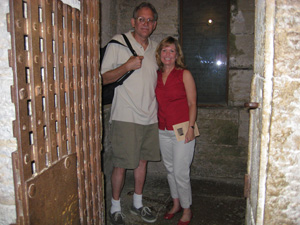 Next we were given a tour of the old town jail. It was built in 1859, with the cells constructed out of native limestone. The bricked portion of the building was the Marshall’s residence, where the family lived with open parts where the children could see right into the jail. The most famous occupant was Jesse’s brother, Frank James, who was treated nicely, and may even have had his meals with the Marshall’s family.
Next we were given a tour of the old town jail. It was built in 1859, with the cells constructed out of native limestone. The bricked portion of the building was the Marshall’s residence, where the family lived with open parts where the children could see right into the jail. The most famous occupant was Jesse’s brother, Frank James, who was treated nicely, and may even have had his meals with the Marshall’s family.
Then it was on to see the McCoy graves in the nearby graveyard. They were all there too, John and William, their wives, children, grandchildren. I imagined them all in the fashions of the times as they stood together mourning their losses. Many of the headstones had been replaced with modern ones, so I was pleased to find the original headstone of poor Robert Stewart McCoy, who died at age 23 in the accidental shooting.
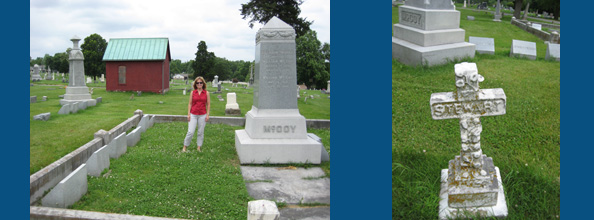
Following are photos of R. Stewart McCoy, first on rear left, and his surveying team.

After the graveyard, we drove to a little park that overlooks where the Missouri used to flow and the steamboats would dock 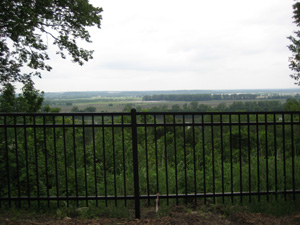 and unload weary travelers and goods. Engineers have since changed the route of the river and made it much narrower here. This whole valley used to be where the river flowed.
and unload weary travelers and goods. Engineers have since changed the route of the river and made it much narrower here. This whole valley used to be where the river flowed.
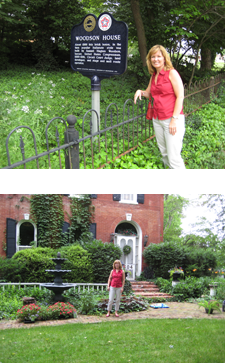
Our tour was some of the historical homes in Independence began at this point. Our first stop was the Woodson House. The house was originally built by Samuel H. Woodson in 1858, and was later rebuilt after a fire. His son Samuel Woodson, Jr., and his wife Jennie McCoy and their daughters Margaret and Elizabeth would visit the Woodsons there often. Jennie McCoy was the only daughter of John and Jane McCoy. Although the house has had many owners since the Woodson’s owned it, and is currently a Bed and Breakfast, it is still identified as The Woodson House because of the important role the Woodsons played in the early days of Independence.
Next Jenell Yoka gave us a tour of her wonderful home. It is the house of Lewis McCoy, who would have been the nephew of John and William McCoy. Not only was it a large, beautiful old house, but she had it furnished with wonderful antiques, including a piano and a modern stove that was designed to look like an old fashioned stove. The house was complete with the names of the McCoy children they had drawn on an attic wall, a new 4-car garage, and formal garden.
It was time for lunch, and we all went to The Courthouse Exchange Restaurant, near the square. Jenell’s husband, David, joined us, and we met David Jackson, of the Jackson County Historical Society there as well. The food and atmosphere were wonderful. A description of the restaurant reads as follows: The Court House Exchange is a casual pub where locals hang out and discuss news of the day, sports, politics, and civic matters. Located below street level, the rock walls, wooden bar and fixtures lend the bar a cozy feel.

Then it was on to the famous First Presbyterian Church where the McCoys, Chrismans, Swopes, Truman’s, and Wallaces all attended. It is the very church where President Harry Truman met Bess Wallace, his future wife, and where John McCoy taught bible school for 65 years. John McCoy actually used the opportunity to teach the children mathematics and Latin, as well, I found out, and this was actually where Harry Truman learned things that helped him throughout his career. The church was quite large, with huge stained-glass windows, many large high-ceilinged rooms, and beautiful woodwork, all ordered from a catalog.
You’ve probably noticed that Sharon has her arm in a sling. The poor thing had been bitten by her cat, Peter, just a few days before we arrived. She picked him up at the end of a cat fight, and he bit her to the bone..ouch!
After that, we headed for the famous Vail Mansion, but before arriving there, we saw more notable sites, including alleys that were the actual roads the covered wagons took on their journeys out west. Following are photos of William Chrisman High School, named after my great great great grandfather, McCoy Park, the first court house, which still stands with the originals logs it was built with, and the railroad station that was used by the early settlers.

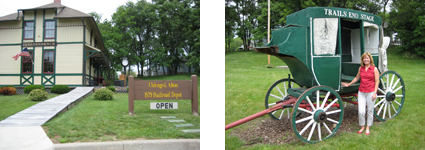
On to our personal tour of the Vaile Mansion by Jenell Yoka, who volunteers there as a tour guide. The 30-room  mansion built by frontier business tycoon Harvey Vaile in 1881 had opulent conveniences like a flushing toilet and brass bathtub. He and his wife did not have children, so it was just occupied by the 2 of them and their servants. Later it was used as a sanitarium for the elderly, where Maggie Chrisman Swope actually lived until her death. It had huge rooms, etc., but the neatest thing was a small room lined with wood where the grain in the wood had been modified to create hundreds of small strange faces. Very unusual, to say the least. Here we are in front of the mansion.
mansion built by frontier business tycoon Harvey Vaile in 1881 had opulent conveniences like a flushing toilet and brass bathtub. He and his wife did not have children, so it was just occupied by the 2 of them and their servants. Later it was used as a sanitarium for the elderly, where Maggie Chrisman Swope actually lived until her death. It had huge rooms, etc., but the neatest thing was a small room lined with wood where the grain in the wood had been modified to create hundreds of small strange faces. Very unusual, to say the least. Here we are in front of the mansion.
After a brief rest at our hotel, our final stop for the day was a dinner at the William McCoy house, currently owned by Brian and Sharon Snyder. Before we go there, however, I’ll fill you in on what happened to John McCoy’s house (my great great grandfather). John McCoy was a very successful merchant. He owned a store and wool mill, and sold yarn up and down the Missouri River. He also obtained the first contract with the U.S. government to carry mail across the plains, according to records at Miami University. His wife, Jane, was an invalid for 45 years. Once when she went home to Chillicothe for a rest, he tore down their house and built a new one that was wheelchair accessible, which was very rare at the time. The house was later torn down by Urban Renewal in the 1970’s. I have a photo of it in my scrapbook.
As we approached the home of John’s brother, William McCoy, I was so pleased that it had not only survived through the years, but that caring people, like the Snyders, had purchased it and were dedicated to restoring it. Not only did the Snyders have the vision and passion to restore and preserve it, but Brian Snyder was actually a structural engineer, enabling him to do some of the work himself. The house could not have been in better hands.
The house was built in 1830 by Samuel Owens, where he lived until his death in 1847. Mr. McCoy received the free title in 1851, and moved in with his bride in 1853, where they lived until his death in 1900. The property is listed on the National Register of Historic Places and is a Santa Fe National Historic Trail Site. Architecturally, the house is an example of the Side Hall Plan with characteristics of the Greek Revival and Italianate styles. In recent years, the house was separated into apartments at one time, and was filmed for an episode of “If Walls Could Talk” since the Snyders have owned it. The most interesting event that took place in the house, however, was during the Civil War when John’s family actually moved in with his brother’s family for their own safety. Union soldiers actually burned down most of the town in an effort to eliminate southern sympathizers. On the morning of August 11th in 1862, the house suddenly filled with Union soldiers as they fought Confederate soldiers to the south. Window glass was breaking and bullets were flying, and you can still see spots on the bricks outside where bullet holes were patched over.

Notice the freshly painted trim, the manicured lawn, which includes numerous rose bushes, and if you look carefully to the left of me, you can even see famous Peter the cat.
Inside Sharon and Brian gave us the big tour beginning with the entrance 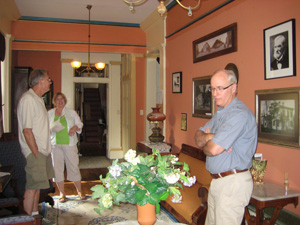 room where William McCoy is said to have spent most of his time. I’m not sure if it was the period décor of if I’m psychic, but I felt a presence when I entered the room, and Sharon said many others have said the same thing.
room where William McCoy is said to have spent most of his time. I’m not sure if it was the period décor of if I’m psychic, but I felt a presence when I entered the room, and Sharon said many others have said the same thing.
When I walked into the living room, I smelled a wonderful blast of flowers. Sharon later informed me that the house sat on 14 acres, and 3 of the acres were just for growing flowers. She has letters documenting the numerous flowers that were always in the house, and said she occasionally smells them when there aren’t any flowers in the room. I felt certain I was being greeted by the spirits of the McCoys, as they surely had flowers in the house when company arrived. You can also see in this photo of  the living room that the ceilings of these homes were often painted with flowers. They Snyders are going to great lengths to have the original ceiling paintings restored. You can see the beautiful stone fireplace and mantel as well. These are also typical of the historic homes in Independence.
the living room that the ceilings of these homes were often painted with flowers. They Snyders are going to great lengths to have the original ceiling paintings restored. You can see the beautiful stone fireplace and mantel as well. These are also typical of the historic homes in Independence.
The Snyders also have displayed many items they have found on the 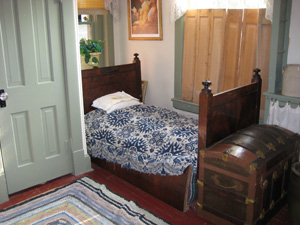 property throughout the years, these include bullets and buttons, and some ceramic drainage pipes. You see, not only did the McCoys grow their own flowers on the property, but they also had their own kiln that they used to make ceramic items from the clay-like earth on their land.
property throughout the years, these include bullets and buttons, and some ceramic drainage pipes. You see, not only did the McCoys grow their own flowers on the property, but they also had their own kiln that they used to make ceramic items from the clay-like earth on their land.
Upstairs, the house held more unexpected treasures. The following photos show a children’s bed, the actual bed of William and Eleanor McCoy, which includes a little roof that extends from the headboard, and last, but not least, William McCoy’s potty. His potty was literally a pot stored in a cabinet that he would use, and a servant would then empty. The cabinet is lined with a nice smelling oil to help with the odor, and believe it or not, you can still smell the oil, and yes, I smelled William McCoy’s potty (and it smelled good).
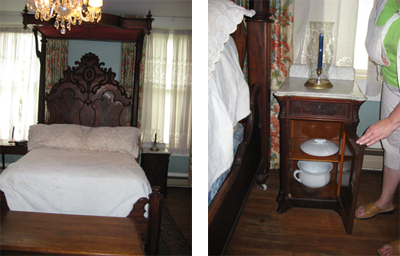
Finally, we ended the evening with a wonderful dinner in the charming dining room where my ancestors surely spent many evenings sharing meals together. Jenell and David Yoka joined us, as well as friend Lee Williams, and David Jackson, the Director of Archives & Education of the Jackson County Historical Society.
room where my ancestors surely spent many evenings sharing meals together. Jenell and David Yoka joined us, as well as friend Lee Williams, and David Jackson, the Director of Archives & Education of the Jackson County Historical Society.
The gourmet dinner was prepared by Jenell and David’s son, professional chef and former neighbor, Daniel Yoka. We told stories and laughed until I was hoarse. Greg and I then returned to the Higher Ground to rest up for another fascinating day.
Next.. Part 2
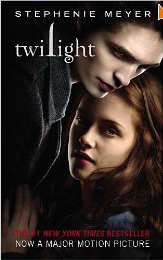 That’s right. I admit it. I’ve been bitten by the Twilight vampire book series, by Stephenie Meyer, and I’m 52 years old. The movies first caught my attention when my co-workers went to see them in packs when they came to nearby theaters. No rush for me though. I eventually rented Twilight, prepared myself for an average movie, and I’m happy to say, that five minutes into the movie, I was hooked. It was fast-paced, realistic, set in an interesting location, and had a wonderfully agonizing love story at its core. I don’t care how old you are; the old “boy and girl love each other but can’t quite have each other” story line always works, especially if the boy rescues the girl at unexpected times.
That’s right. I admit it. I’ve been bitten by the Twilight vampire book series, by Stephenie Meyer, and I’m 52 years old. The movies first caught my attention when my co-workers went to see them in packs when they came to nearby theaters. No rush for me though. I eventually rented Twilight, prepared myself for an average movie, and I’m happy to say, that five minutes into the movie, I was hooked. It was fast-paced, realistic, set in an interesting location, and had a wonderfully agonizing love story at its core. I don’t care how old you are; the old “boy and girl love each other but can’t quite have each other” story line always works, especially if the boy rescues the girl at unexpected times.


















